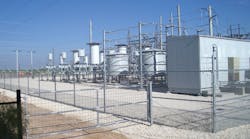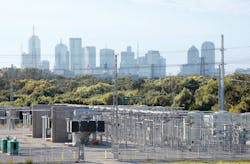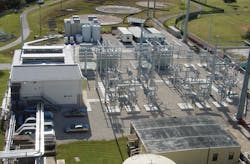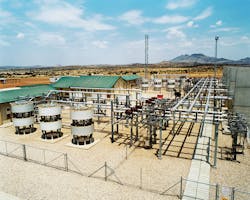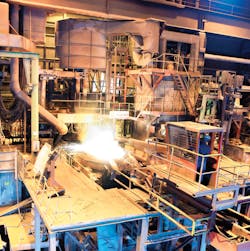Supply and demand is a relatively simple concept. Customers want electricity and utilities supply it to them. What makes it trickier is moving from the straightforward point-to-point transmission system to a complex mesh network covering fantastic distances. The global trend is toward larger power networks with longer transmission lines, more generation and higher consumption of electricity. With networks came the requirement for redundancy to increase reliability, and reliability became the utility’s prime directive.
It did not help that utilities switched from the relatively unsophisticated use of electricity for lightbulbs and motors to a smart grid powering powerful computers, intricate microprocessors and other finicky high-tech devices needing the highest power quality possible. Meeting the demand for cutting-edge electricity has required utilities to search for ways to improve their electric-delivery systems. Many have done this by deploying the latest technologies as they become available, which has been challenging for reliability-based utilities.
Congestion, loop flows and capacity problems traditionally have been removed by adding more wire in the air, but that is not as easy as it once was. Rising costs, budget constraints and environmental concerns have made the process of adding new lines complicated, time-consuming and expensive. Therefore, making existing lines as well as new ones more efficient and economical only makes good sense.
No-Wires Solution
Fortunately, the electric utility industry has been developing alternative technologies — commonly called flexible ac transmission systems (FACTS) — to the traditional wire-in-the-air solution. FACTS controllers are both compelling and attractive to utilities chartered with being operationally reliable and financially profitable.
Power electronics-based equipment using thyristors and transistors to control traditional capacitor and reactor apparatuses offer an alternative technology that not only improves transmission system operation, but does so without having to undertake major system alternations or additions. The implementation time is minimal compared to the construction of new transmission lines as is the impact to the environment.
The U.S. Department of Energy’s (DOE’s) Office of Electricity Delivery and Energy Reliability published a recent report that gives a decent perspective of the grid and its adaptation of this solid-state gear.
The DOE report stated, “Presently 30% of all electric power generated uses power electronics technologies somewhere between the point of generation and the end user.”
The report also stated, “By 2030, 80% of all electric power will flow through power electronics.”
Another DOE report goes further by saying, in the future, power electronics will be critical to improve the electric power flow and support the expanding demand for electricity by all sectors of society.
FACTS technology is not new; it has been in use since the 1970s. But, lately, the technology has been attracting a lot of interest as utilities study its potential benefits. The term FACTS does not refer to any single device, but rather a collection of controllers that can be connected in parallel, series or a combination of both within the transmission and distribution networks in a building block methodology.
FACTS controllers have proven attractive to grid operators because of their ability to alleviate power system constraints by their fast response times, smooth control and cyclic (repeated) operation. As a result, FACTS technology is a growth technology. PRWeb reported in late 2013 that the FACTS controllers market was valued at approximately US$913 million in 2012 and is expected to increase to about $1.386 billion by 2018.
Various marketing research groups report that static VAR compensator (SVC) and static synchronous compensator (STATCOM) controllers are the most prevalent FACTS devices. These devices make up between 80% and 90% of the market for overall compensation for electric utilities and industrial applications installed in 2013. One report lists the major players in this global FACTS market as ABB, Alstom, Siemens, General Electric, Mitsubishi Electric, American Superconductor and Toshiba.
The Difference
It seems as though everybody uses the terms SVC and STATCOM interchangeably, like they are different names for the same device. Part of the confusion is the fact that SVCs and STATCOMs are very similar in nature, but they really are different. Probably the most significant difference is in the design. SVCs use thyristors while STATCOMs use transistors.
The classical SVC is a solid-state reactive power compensation device that takes advantage of some of power electronics’ basic components known as thyristor-switched capacitors (TSC) and thyristor-controlled reactors (TCR) to supply or absorb volt-amperes reactive (VAR). While the SVC is not new, its technology continues to advance and mature, enabling modern-day applications designed with faster voltage support to continue to be applied to the grid.
When the STATCOM came along, it had a built-in fan base thanks to the SVC’s proven track record and popularity. The STATCOM has all the advantages of the classic SVC plus some advantageous enhancements such as the compensation being independent of the grid impedance in many cases. STATCOMs also provided active harmonics cancellation. This ability means the STATCOM does not need harmonic filters, which saves a lot of real estate when building one. In addition, they improve power quality with their dynamic transfer capability for both active and reactive power.
Moreover, STATCOMs provide the dynamic voltage balancing needed when the loads are unsymmetrical and fluctuating rapidly. To be fair, the SVC is still superior to the STATCOM’s short-term overload capability. The STATCOM has practically no overload capacity.
A STATCOM basically acts like a generator but without a prime mover or inertia. The fundamental principle behind the STATCOM is it converts a dc input voltage into an ac output voltage to compensate the active and reactive needs of the system. When the system voltage drops sufficiently to force the STATCOM output to its limit, its maximum reactive power output will not be affected by the voltage magnitude. It has a smaller footprint and faster dynamic response.
SVC or STATCOM
So, what is the best device to use, the SVC or STATCOM? Well, it depends on the application. A good example of this SVC or STATCOM application choice took place in Texas a few years ago. Oncor needed to improve its electric-delivery system in the Dallas-Fort Worth area. This area is growing at a fantastic rate and had some voltage support and dynamic reactive power issues.
Local generation dispatch had changed over the years as wind generation penetrated the transmission system. Oncor compared traditional mechanically switched capacitors, SVCs and STATCOMs for the project. It found conventional capacitors were not effective with the rapidly fluctuating network conditions. The SVC provided the best solution with its large-capacity abilities and was selected for the project.
Oncor selected ABB to build what was the world’s largest cluster of SVCs, with a total rating of +600/-530 MVAR, in the Dallas-Fort Worth area. The installation was successful, and Oncor has added several more SVCs to its service area to support the transmission grid.
On the STATCOM side of the technology, Austin Energy retired its four-unit Holly power plant several years ago. This was brought about because of the plant’s age, availability of cheaper generation and environmental concerns from a developing urban neighborhood. The plant provided 590 MW of active power and 348 MVAR of reactive power. Austin Energy decided a FACTS solution was needed to provide the lost reactive power for voltage stability. It settled on a ±100-MVAR STATCOM built by ABB.
The challenge to ABB was to build an inconspicuous device since it would be installed at the old Holly site, which is located in an area adjacent to a park with ambient noise restrictions. The STATCOM was an ideal application and ABB came up with an innovative design locating the STATCOM inside a two-story building at the Holly facility. In addition to the reactive power support, the STATCOM also controls three mechanically switched 31.2-MVAR capacitor banks coordinated with the STATCOM’s operation. This technology proved to be the best fit for the project on many levels.
Still Evolving
FACTS technologies continue to grow and mature as the complexities of grid operations increase, but it seems the SVCs and STATCOMs are accelerating faster. One such area is that of increased ratings available to SVC users. In the early days of the device, voltage levels were low, as were reactive power ratings. Those early SVCs were small by today’s standards with 5-kV and 10-kV levels common. Their reactive power outputs were small, too, with ranges of 30 MVAR and 40 MVAR.
They worked so well, utilities wanted FACTS devices with higher ratings. Technologies improved and today’s controllers are capable of connecting to just about every voltage level in service, including the ultrahigh voltages so common on bulk power systems. The reactive power output also is reaching new levels with reactive power being supplied in the hundreds of megavolt-amperes reactive.
SVCs are being applied worldwide. Korea Electric Power Corp. (KEPCO) recently announced it will be installing its largest SVC to date manufactured by NR Electric. It will be installed in KEPCO’s 345-kV Shin-Paju substation and have an installed capacity of ±200 MVAR. In Brazil, CEMIG recently reported it will be installing an Alstom SVC connected to the 500-kV grid in Brazil rated at -200/+300 MVAR (SVC for its Bom Despacho project). This will be one of the largest SVCs in Brazil. In North America, Southern California Edison has installed a -110/+605-MVAR Siemens SVC at its 500-kV Devers substation. The size of this type of device continues to grow.
On the STATCOM front, probably the most significant event to happen took place in the early 1990s when ABB introduced voltage source converter (VSC) technology. VSC technology happened first in the high-voltage dc (HVDC) portion of the industry, but it did not take long for it to find its way to FACTS controllers. The technology is based on the insulated-gate bipolar transistor (IGBT), which is a self-commutated device that can be switched at any time with frequencies of hundreds of hertz.
When it was combined with another technology advancement known as pulse-width modulation (PWM), response times improved significantly, harmonic distortions were reduced dramatically and the popularity of STATCOMs increased exponentially.
Initially, the IGBT did not have the ability to handle large power capacities its predecessors did, but its other capabilities more than made up for that. Over the years, since the adoption of IGBT, its characteristics have advanced and matured, and reactive power ratings have pushed ahead.
Chile’s leading power transmission utility Transelec selected ABB to design and install the world’s largest transistorized STATCOM, at that time, in its Cerro Navia substation in Santiago. It happened in 2011 when Transelec needed to increase power transfer across its 500-kV system. The STATCOM provided -65/+140 MVAR of reactive power to the grid.
Maturing and Enhancing
In the years that followed, STATCOM reactive power ratings grew in size with just about every project. The China Southern Power Grid (CSG) utility recently announced it had installed a ±200-MVAR STATCOM in its 500-kV Dongguan substation. CSG formed a consortium with Tsinghua University and Rongxin Power Electronic to develop this STATCOM. They reached this rating by using a two VSC topology, but it’s not just about size. STATCOMs have been evolving to offer enhancements needed by the changing grid.
Combining energy storage with a STATCOM controller has gotten attention from utilities with voltage support problems on feeders. The energy storage device can be made up of several commercially available devices, but the most accepted system uses a battery connected in series with the STATCOM. Energy storage enables the STATCOM to deliver and consume active power. It is a device that can offer a dynamic rating of both active and reactive power support over the entire P-Q diagram.
EDF Energy in Norfolk, England, installed the first such device on its 11-kV distribution system. It was an ABB design using Saft’s high-performance lithium-ion batteries. The STATCOM system has a 600-kVAR reactive power capacity with a 600-kW active power rating and 200-kWh capacity. It is a load-balancing system capable of modulating both reactive and active power output, which improves power oscillation damping and permits higher power transfer levels.
Another intriguing advancement is the transformerless SCV/STATCOM. ABB has built four 69-kV TCRs for an American Electric Power project in the McCamey area of West Texas. In addition, Pacific Gas & Electric has installed two ABB transformerless 60-kV TCRs on its syst em. STATCOMs are available in this new configuration up to 36 kV, and soon there will be transformerless STATCOMs at 66 kV.
The Future Is Calling
Since there is no sign of power demands dropping, grid congestion abating or requirements for renewable generation declining, it is a good bet new applications for FACTS controllers will continue to be found. Case in point, short-circuit currents are increasing at major interconnection hubs. Any technology that limits those currents is high on operators’ wish lists.
So, it should not be surprising FACTS technology is under development to control short-circuit currents using a combination of power electronics, series reactors and series capacitors. When a short circuit is detected, the series capacitor is bypassed by a thyristor-protected device and the short-circuit current is limited by the series reactor.
Regulators also have become aware of FACTS and, as a result, there is a growing awareness on their part for the need of reactive power support on the grid. An example of this is the increasing concern displayed by the North American Electric Reliability Corporation (NERC), which has has been concerned with fault-induced delayed voltage recovery for several years. NERC’s Emerging Issue #RAS-8 talks about installing transmission-based dynamic megavolt-amperes reactive, which is a bureaucratic way of saying FACTS devices.
In Europe, the European transmission system operators have imposed stringent grid codes to limit the impact of intermittent generation on network power quality. Many say they are cracking the grid code with the application of FACTS controllers.
All of this innovation and evolution is giving a radical new definition to the old concept of plug and play. These modular FACTS building blocks can be combined in a variety of configurations with the ultimate aim being the ability to stabilize any grid-voltage excursion and minimize any transient disturbance. The fact that the FACTS business has increased well beyond the expectations of all the experts bears witness to the need for this equipment by the industry as it works to meet the demands of customers.
